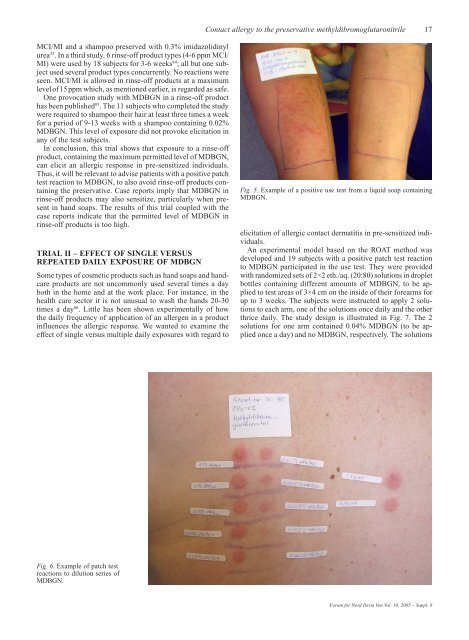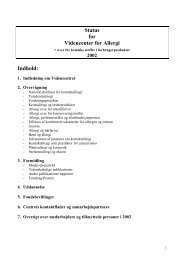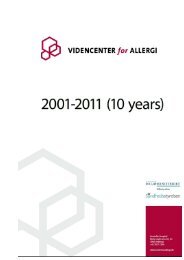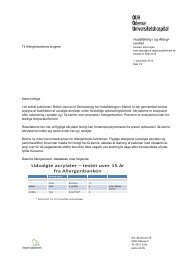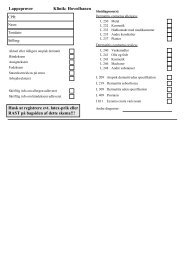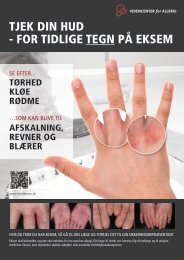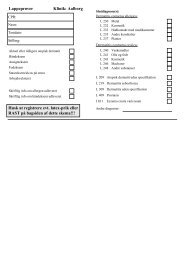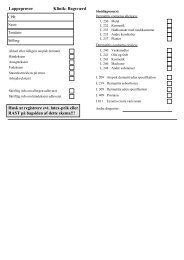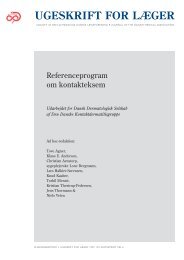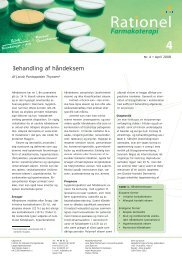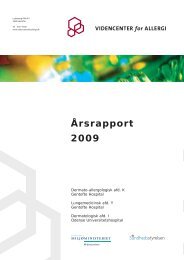Charlotte Devantier Jensen.pmd - Videncenter for Allergi
Charlotte Devantier Jensen.pmd - Videncenter for Allergi
Charlotte Devantier Jensen.pmd - Videncenter for Allergi
Create successful ePaper yourself
Turn your PDF publications into a flip-book with our unique Google optimized e-Paper software.
MCI/MI and a shampoo preserved with 0.3% imidazolidinyl<br />
urea 35 . In a third study, 6 rinse-off product types (4-6 ppm MCI/<br />
MI) were used by 18 subjects <strong>for</strong> 3-6 weeks 84 ; all but one subject<br />
used several product types concurrently. No reactions were<br />
seen. MCI/MI is allowed in rinse-off products at a maximum<br />
level of 15 ppm which, as mentioned earlier, is regarded as safe.<br />
One provocation study with MDBGN in a rinse-off product<br />
has been published 85 . The 11 subjects who completed the study<br />
were required to shampoo their hair at least three times a week<br />
<strong>for</strong> a period of 9-13 weeks with a shampoo containing 0.02%<br />
MDBGN. This level of exposure did not provoke elicitation in<br />
any of the test subjects.<br />
In conclusion, this trial shows that exposure to a rinse-off<br />
product, containing the maximum permitted level of MDBGN,<br />
can elicit an allergic response in pre-sensitized individuals.<br />
Thus, it will be relevant to advise patients with a positive patch<br />
test reaction to MDBGN, to also avoid rinse-off products containing<br />
the preservative. Case reports imply that MDBGN in<br />
rinse-off products may also sensitize, particularly when present<br />
in hand soaps. The results of this trial coupled with the<br />
case reports indicate that the permitted level of MDBGN in<br />
rinse-off products is too high.<br />
TRIAL II – EFFECT OF SINGLE VERSUS<br />
REPEATED DAILY EXPOSURE OF MDBGN<br />
Some types of cosmetic products such as hand soaps and handcare<br />
products are not uncommonly used several times a day<br />
both in the home and at the work place. For instance, in the<br />
health care sector it is not unusual to wash the hands 20-30<br />
times a day 86 . Little has been shown experimentally of how<br />
the daily frequency of application of an allergen in a product<br />
influences the allergic response. We wanted to examine the<br />
effect of single versus multiple daily exposures with regard to<br />
Fig. 6. Example of patch test<br />
reactions to dilution series of<br />
MDBGN.<br />
Contact allergy to the preservative methyldibromoglutaronitrile 17<br />
Fig. 5. Example of a positive use test from a liquid soap containing<br />
MDBGN.<br />
elicitation of allergic contact dermatitis in pre-sensitized individuals.<br />
An experimental model based on the ROAT method was<br />
developed and 19 subjects with a positive patch test reaction<br />
to MDBGN participated in the use test. They were provided<br />
with randomized sets of 2×2 eth./aq. (20:80) solutions in droplet<br />
bottles containing different amounts of MDBGN, to be applied<br />
to test areas of 3×4 cm on the inside of their <strong>for</strong>earms <strong>for</strong><br />
up to 3 weeks. The subjects were instructed to apply 2 solutions<br />
to each arm, one of the solutions once daily and the other<br />
thrice daily. The study design is illustrated in Fig. 7. The 2<br />
solutions <strong>for</strong> one arm contained 0.04% MDBGN (to be applied<br />
once a day) and no MDBGN, respectively. The solutions<br />
Forum <strong>for</strong> Nord Derm Ven Vol. 10, 2005 – Suppl. 8


